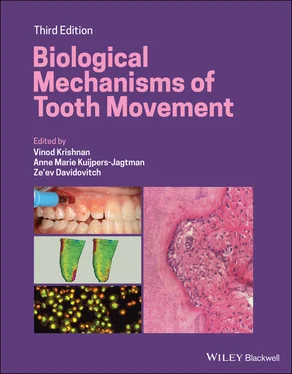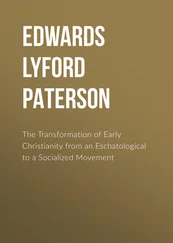35 Pavlin, D., Zadro, R. and Gluhak‐Heinrich, J. (2001) Temporal pattern of osteoblast associated genes during mechanically induced osteogenesis in vivo: early responses of osteocalcin and type I collagen. Connective Tissue Research 42, 135–148.
36 Persson, M. (2005) A100th anniversary: Sandstedt’s experiments on tissue changes during tooth movement. Journal of Orthodontics 32, 27–28.
37 Picton, D. C. A. (1965) On the part played by the socket in tooth support. Archives of Oral Biology 10, 945–955.
38 Reitan, K. (1957) Some factors determining the evaluation of forces in orthodontics. American Journal of Orthodontics 43, 32–45.
39 Reitan, K. (1958) Experiments of rotation of teeth and their subsequent retention. Transactions of the European Orthodontic Society 34, 124–138.
40 Reitan, K. (1961) Behavior of Malassez’ epithelial rests during orthodontic tooth movement. Acta Odontologica Scandinavia 19, 443–468.
41 Reitan, K. and Kvam, E. (1971) Comparative behavior of human and animal tissue during experimental tooth movement. The Angle Orthodontist 41, 1–14.
42 Reyna, J., Beom‐Moon, H. and Maung, V. (2006) Gene expression induced by orthodontic tooth movement and/or root resorption, in Biological Mechanisms of Tooth Eruption, Resorption, and Movement (eds Z. Davidovitch, J. Mah and S. Suthanarak). Harvard Society for the Advancement of Orthodontics, Boston, pp. 47–76.
43 Rygh, P. (1974) Elimination of hyalinized periodontal tissues associated with orthodontic tooth movement. Scandinavian Journal of Dental Research 82, 57–73.
44 Rygh, P. (1976) Ultrastructural changes in tension zone of rat molar periodontium incident to orthodontic tooth movement. American Journal of Orthodontics 70, 269–281.
45 Rygh, P. and Selvig, K. A. (1973) Erythrocytic crystallization in rat molar periodontium incident to tooth movement. Scandinavian Journal of Dental Research 81, 62–73.
46 Sandstedt, C. (1901) Någrabidrag till tandregleringensteori. Kungl. Boktryckeriet, Stockholm.
47 Sandstedt, C. (1904) Einige Beiträge zur Theorie der Zahnregulierung. Nordisk Tandläkare Tidskrift 5, 236–256.
48 Sandstedt, C. (1905) Einige Beiträge zur Theorie der Zahnregulierung. Nordisk Tandläkare Tidskrift 6, 1–25, 141–168.
49 Sandy, J. R., Farndale, R. W. and Meikle, M. C. (1993) Recent advances in understanding mechanically induced bone remodeling and their relevance to orthodontic theory and practice. American Journal of Orthodontics and Dentofacial Orthopedics 103, 212–222.
50 Schwarz, A. M. (1932) Tissue changes incidental to orthodontic tooth movement. International Journal of Orthodontia, Oral Surgery and Radiography 18(4), 331–352.
51 Storey, E. (1973) The nature of tooth movement. American Journal of Orthodontics 63(3), 292–314.
52 Vasconcellos Vilella, O. D. (2007) Development of orthodontics in Brazil and in the world. Revista Dental Press de Ortodontia e Ortopedia Facial 12(6), 131–156. https://dx.doi.org/10.1590/S1415‐54192007000600013((accessed August 25, 2019).).
53 Wahl, N. (2005a) Orthodontics in 3 millennia. Chapter 1: Antiquity to the mid‐19th century. American Journal of Orthodontics and Dentofacial Orthopedics 127, 255–259.
54 Wahl, N. (2005b) Orthodontics in 3 millennia. Chapter 2: Entering the modern era. American Journal of Orthodontics and Dentofacial Orthopedics 127, 510–515.
55 Weinberger, B. W. (1926) Orthodontics: A Historical Review of its Origin and Evolution. C. V. Mosby, St. Louis, MO.
56 Yamaguchi, M. (2009). RANK/RANKL/OPG during orthodontic tooth movement. Orthodontics & Craniofacial Research 12(2), 113–119.
57 Zengo, A. N., Pawluk, R. J. and Bassett, C. A. L. (1973) Stress‐induced bioelectric potentials in the dentoalveolar complex. American Journal of Orthodontics 64, 17–27.
58 Zhang, D., Yang, Y. Q., Li, X. T. and Fu, M. K. (2004) The expression of osteoprotegerin and the receptor activator of nuclear factor kappa B ligand in human periodontal ligament cells cultured with and without 1α, 25–dihydroxyvitamin D3. Archives of Oral Biology 49, 71–76.
59 Zhao, N., Lin, J., Kanzaki, H. et al. (2012). Local osteoprotegerin gene transfer inhibits relapse of orthodontic tooth movement. American Journal of Orthodontics and Dentofacial Orthopedics 141(1), 30–40.
CHAPTER 2 Biology of Orthodontic Tooth Movement: The Evolution of Hypotheses and Concepts
Vinod Krishnan and Ze’ev Davidovitch
Orthodontic treatment has been practiced for 2000–3000 years, but the last century‐and‐a‐half has witnessed major advances in the accumulation of meaningful biological information, which facilitates the formulation of hypotheses that help in the design, explanation, and improvement of clinical procedures. These hypotheses focus on the biological nature of the physical and biochemical events, which occur in teeth and their surrounding tissues following the administration of mechanical forces. Among the chief hypotheses are those related to creation of tissue strain and electrical signals that stimulate the cells in the regions affected by these forces. These studies revealed extensive cellular activities in the mechanically stressed periodontal ligament, involving neurons, immune cells, fibroblasts, endothelial cells, osteoblasts, osteoclasts, osteocytes, and endosteal cells. Moreover, mechanical stresses were found to alter the structural properties of tissues at the cellular, molecular, and genetic levels. The rapid reactions occurring at the initial stage of mechanotherapy, and slower adaptive changes at the later stages of treatment, have attracted increasing attention. This chapter addresses the evolutionary traits of the development of concepts pertaining to the biology of orthodontic tooth movement.
Orthodontic tooth movement (OTM) is facilitated by remodeling of the dental and paradental tissues which, when exposed to varying degrees of magnitude, frequency, and duration of mechanical loading, express extensive physical and chemical changes that differ from the processes of physiological dental drift, or tooth eruption. In OTM, a tooth moves as a result of mechanical forces derived from external devices, while forces leading to mesial migration of teeth are derived from the individual’s own musculature, and tooth eruption results from complex interactions between dental and paradental cells. The common denominator of all these phenomena is the generation of mechanical forces, either physiologically or therapeutically. OTM resembles tooth eruption because both processes depend on remodeling of the periodontal ligament (PDL) and the alveolar bone, but the two processes present different models of bone remodeling (Davidovitch, 1991; Wise and King, 2008). The status of bone metabolism determines the specific characteristics of tissue remodeling associated with tooth eruption and OTM. In both cases mechanical forces are applied to the teeth, which are transmitted through the PDL to the alveolar bone, followed by an instantaneous cellular reaction. The details of this reaction have been the main target of investigation since the end of the nineteenth century. However, since orthodontic forces are usually greater than the forces of eruption, the tissue reaction during OTM may include iatrogenic injury to teeth and their surrounding tissues. OTM can occur rapidly or slowly, depending on the physical characteristics of the applied force, and the size and biological response of the PDL. Typically, when a tooth is tipped by mechanical forces, the root movement within the PDL develops areas of compression and of tension. When optimal forces are applied, alveolar bone resorption occurs in PDL compression sites, while new bone apposition takes place on the alveolar bone surfaces facing the stretched PDL (Sandstedt, 1904, 1905; Oppenheim, 1911; Schwarz, 1932). However, when the applied force exceeds a threshold, cells in the compressed PDL may die, and the orientation of the collagenous PDL fibers may change from horizontal to vertical. This change in PDL fiber orientation causes the necrotic area to appear opaque in the microscope, resembling the appearance of hyaline cartilage (Reitan, 1960). Tooth movement will resume only after these hyalinized tissues and the adjacent alveolar bone are removed by invading cells from the adjacent viable PDL or alveolar bone marrow spaces. Some of these cells coalesce to form multinucleated osteoclasts, targeting the alveolar bone, while macrophages that are attracted to the site remove the necrotic PDL, thus enabling the tooth to move.
Читать дальше












